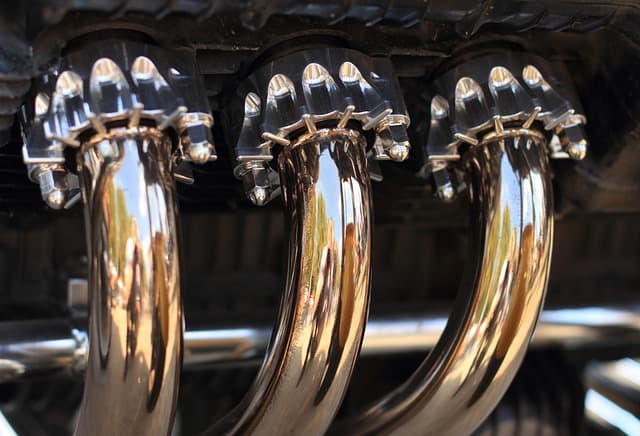Exhaust leaks are not uncommon in the motorcycle world. Most of them happen right where the headers connect to the cylinder head, and most riders immediately recognize an exhaust leak just by the slight change in the way it sounds. But how do you even check for exhaust leaks on motorcycles?
In this article, we’ll talk about that and more. So without further ado, let’s get you back on the road.
Motorcycle Exhaust Leak Symptoms
1. Distinct Ticking Noise
It’s probably the most common and the most obvious symptom. In most cases, the leak occurs at the area where the headers connect to the cylinder head.

What happens is that over time and with many heat cycles, the nuts holding the exhaust headers to the cylinder head start to loosen and create an air gap for exhaust gases to escape.
But if it’s not the loose nuts and bolts, then a blown exhaust gasket is the most likely culprit as they do go bad eventually.
2. Black Soot/Carbon Deposits
If the exhaust leak has been there for quite some time, you will see black soot/carbon deposits around the leak area. These can be quite difficult to spot if they’re somewhere around the exhaust gasket area, but they’re quite visible when the leak is at the welds.
3. Backfiring on Deceleration
When there’s an exhaust leak around the area where the headers and the cylinder head meet, fresh air sometimes gets sucked in and mixes with the partially burnt fuel mixture, and explodes. If your bike suddenly started making popping sounds out of the exhaust, you might have an exhaust leak.
How To Check for Motorcycle Exhaust Leaks
A lot of people would tell you to simply block the exhaust with a rag and listen or feel around for obvious leaks with the engine running. This works fine, but if you have a shop vacuum, which doubles as a blower – you’ll have a much better chance of finding a leak.
If you don’t have a shop vac, you can still do the test by running your engine. The only downside to that is that the engine needs to be cold and you’ll only have a minute or two before it gets too hot.
Now, 90% of exhaust leaks on motorcycles occur in the area where the headers connect to the cylinder head. Because of that, it might be a good idea to tighten the fasteners that are holding the headers to the cylinder head. It’s easy to do and if you notice a difference after doing that, then you’ve found your leak.
But if you need to do a thorough check, here’s how you do it with a shop vac:
- Make sure that your engine is cold. To prevent soapy water from evaporating immediately, the test has to be done on a cold engine. So wait until you can comfortably hold your hand on the engine and the headers or do it in the morning.
- Insert the vacuum hose into the exhaust and make it as air-tight as you can. We’ll be pressurizing the exhaust by using the blower function on the shop vac, so make sure that it fits snug and doesn’t leak too much air. Use duct tape to seal it as best you can.
- Turn on the shop vac to pressurize the exhaust system. Don’t worry, it won’t damage your engine at all – the pressure coming from the shop vac is barely noticeable when compared to the pressure that the engine produces. Do not start the engine.
- Spray soapy water around the exhaust pipe. The majority of exhaust leaks on motorcycles occur right where the headers meet the cylinder head, so spray that area liberally. If you suspect a leak somewhere else, spray it there as well (welds are the second most common weak point).
- Look out for any bubbles. If you see any bubbles – you found your leak. Keep in mind that you might need to really soak the exhaust with soapy water to get the best results.
If you don’t have a shop vac around, you can still do this test without it. However, the engine needs to be cold and you’ll only have a minute or two to find the leak before the engine gets hot enough to evaporate the soapy water.
Here’s how you do it without a shop vac with a blower function:
- Make sure that your engine is cold. Again, this is very important. The colder the engine is, the bigger of a timeframe you will have to find the exhaust leak.
- Block off the exhaust with a rag. By plugging the exhaust, you will force exhaust gases to flow through the leaks. Doing this won’t damage the engine as some air will still escape through the rag, but you might need a second person to hold the exhaust plugged while you look for leaks.
- Start the engine and quickly spray soapy water on the exhaust. Once you start the engine, you’ll only have a minute or two before the engine gets too hot for the soapy water, so make sure you act fast.
- Look for bubbles. Since the engine is running and increasing in temperature, you will need to spray a lot of soapy water. Bubbles indicate a leak, and if you don’t see any bubbles – your exhaust is leak-free.
Jake is the site’s primary contributor.
Motorcycles and automotive repair have been a big part of his family for generations, therefore it’s only natural that he decided to become a heavy-duty diesel tech.
Outside of work, you’ll find Jake restoring and riding rare street bikes and ATVs.